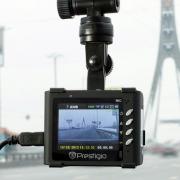Using Dashcams To Aid Amber Alerts
 Image by Paul Townsend via flickr
Image by Paul Townsend via flickrThese days it seems like everyone who has a car has a dash cam. Well, maybe not everybody but there are significant benefits to having a dashcam. One area where dashcams could potentially have a huge impact is in finding missing persons based on Amber Alerts that involve vehicles. It seemed so obvious that I thought this application of dashcams might already exist.
Alas, when I searched online for dashcams that might support this feature, I could find none. Perhaps there are some technical issues holding back this use of dashcams. I will try to list and address them here.
If I haven't thought of something, please feel free to add them to the comments below.
The obvious problem is how does one take an object like a vehicle and have it be recognized in a sea of other vehicles in different lighting and weather conditions? Rather than looking for the vehicle itself, how about encoding vehicle data (type (SUV, sedan, etc), make, model, color, license plate, last known location, etc) to a set of strings that can be transmitted quickly from a centralized database to dashcams participating in searching for the suspect vehicle.
The dashcam therefore wouldn't have to uniquely identify the vehicle but should it see a vehicle that meets the criteria to a certain confidence level, it could take a snapshot of it and transmit a high-resolution image, along with other data like location, time of day, direction of travel, etc., back to the datacenter where high-powered computing resources could use AI to further filter the incoming data to narrow down the list of suspected vehicles to the one being sought.
To transmit, the dashcam could pair with a smart phone and use it as a hotspot to send and receive data. Should a valid connection to the datacenter not be available, the data could be stored until such time where a connection could be reestablished for transmission. Upon successful delivery, the data from the dashcam would be wiped to recover storage space.
To avoid privacy issues datacenters should also delete any irrelevant data once it has been analyzed. I suspect this process would work similarly to SETI, which also receives a large amount of data and once processed, is immediately discarded.
Microprocessors have become small, powerful and economical enough that I think this should be quite doable. Of course, this would be a non-profit venture and drivers wouldn’t directly benefit from using their dashcams and Wi-Fi connections in this way so whether this is practical remains to be seen. Perhaps that is the reason we haven’t seen the availability of this technology. I hope it is because no one has thought of it yet and not because it doesn’t serve anyone’s self-interest.
If you liked this, you may also be interested in an article I wrote about using facial recognition to find missing persons.

Add new comment